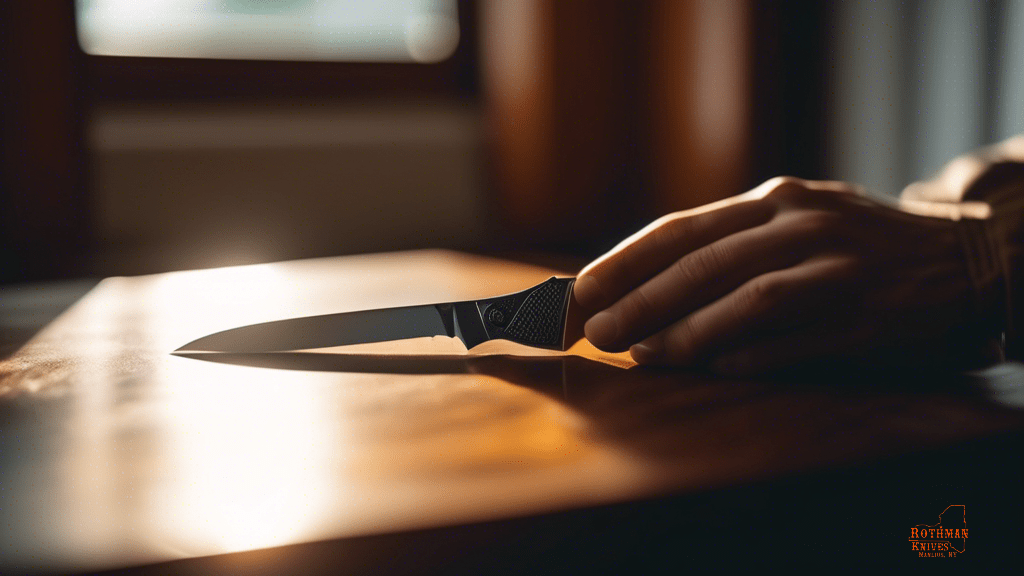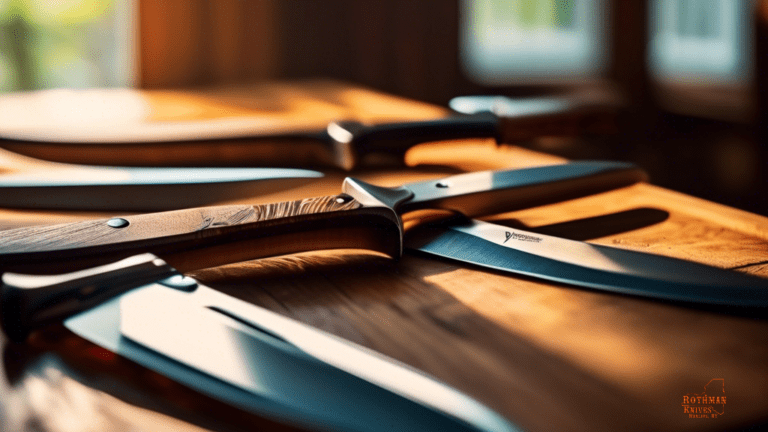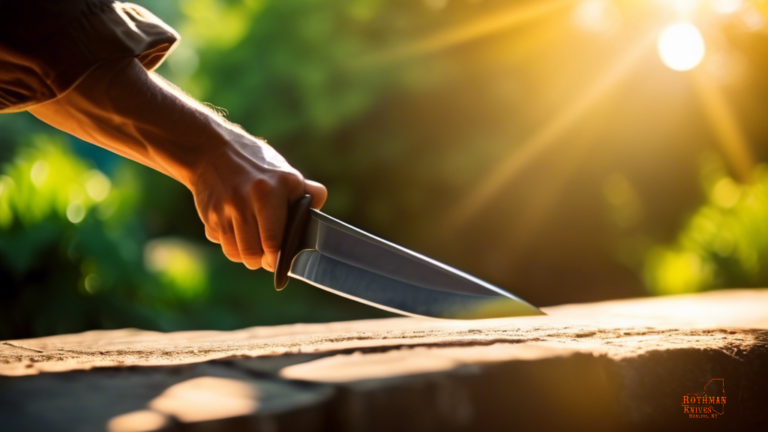Have you ever found yourself in a situation where you needed a reliable tool to help you out, and your trusty folding pocket knife came to the rescue?
Imagine you’re out camping with friends, and a rope needs cutting, or you’re at a picnic and need to slice some fruit.
Folding pocket knives are versatile and handy tools that can come in useful in various everyday situations.
However, it’s essential to prioritize safety when using these knives to prevent accidents and injuries.
In this article, we will explore essential safety tips for using folding pocket knives to ensure that you can enjoy the convenience and utility they provide without putting yourself or others at risk.
From choosing a high-quality knife to proper handling techniques, maintenance, and storage, we’ll cover everything you need to know to use your folding pocket knife safely and responsibly.
So, whether you’re a seasoned outdoors enthusiast or just looking for a practical tool to carry with you, these safety tips will help you make the most of your folding pocket knife while keeping yourself and those around you safe.
Key Takeaways
- Choose high-quality knives with durable handles, strong blade material, and reliable locking mechanisms.
- Properly handle the knife by gripping it firmly and confidently.
- Regularly maintain and sharpen the knife for optimal performance.
- Ensure the knife has safety features and lock mechanisms like liner lock, frame lock, and lockback.
Choosing a High-Quality Folding Pocket Knife
When choosing a high-quality folding pocket knife, make sure to look for a durable handle that feels comfortable in your hand and a blade made of strong, rust-resistant material like stainless steel.
A good knife should also have a reliable locking mechanism to prevent accidental closing while in use.
Remember, the best knife for you is the one that feels like an extension of your hand, so take your time to find the perfect fit.
As part of the knife enthusiast community, you understand the importance of having a reliable tool by your side.
By investing in a high-quality folding pocket knife, you not only gain a valuable tool but also a sense of belonging to a group of like-minded individuals who appreciate the craftsmanship and utility of a well-made blade.
So, go ahead and choose a knife that speaks to you and enhances your everyday carry experience.
Proper Handling and Grip Techniques
To handle your folding knife safely, make sure to grip it firmly with your fingers wrapped securely around the handle. This ensures that you have full control over the knife and reduces the risk of accidental slips or drops.
Find a grip that feels comfortable and secure in your hand, allowing you to confidently use the knife without any hesitations.
When using your folding pocket knife, always maintain a firm grip and avoid any unnecessary movements that could lead to accidents. Remember, the key to proper handling is to feel connected to your knife, almost as if it’s an extension of your hand.
By mastering the grip techniques, you’ll not only enhance your safety but also feel a sense of belonging to the community of knife users who prioritize safety above all else.
Maintaining and Sharpening Your Knife
Make sure you regularly sharpen your knife to keep it in top condition for any task at hand. A sharp knife not only performs better but also reduces the risk of accidents due to slips and mishaps.
Here are a few tips to help you maintain and sharpen your folding pocket knife:
- Invest in a good quality sharpening stone or tool to ensure your blade stays sharp.
- Learn the proper technique for sharpening your knife to prevent damage to the blade.
- Regularly clean your knife after use, removing any dirt or debris that could affect its performance.
By taking the time to care for and sharpen your knife, you’ll not only extend its lifespan but also ensure that it remains a reliable tool for all your cutting needs. Remember, a well-maintained knife is a safe knife.
Using Safety Features and Lock Mechanisms
Remember, these knives are built like tanks to keep your fingers safe! When using folding pocket knives, it’s crucial to understand and utilize the safety features and lock mechanisms in place. These mechanisms are designed to prevent the blade from accidentally closing on your fingers during use, ensuring a secure and safe cutting experience.
To help you better understand how these safety features work, here is a breakdown of common mechanisms found in folding pocket knives:
| Mechanism | Description | Safety Tip |
|---|---|---|
| Liner Lock | A thin metal liner inside the handle locks the blade | Ensure the liner is engaged before using the knife |
| Frame Lock | The handle frame moves behind the blade to lock it | Check that the frame lock is fully engaged |
| Lockback | A locking bar extends along the back of the handle | Press down on the locking bar to release the blade |
By familiarizing yourself with these mechanisms and following the corresponding safety tips, you can confidently use your folding pocket knife without the fear of accidental injuries. Remember, safety always comes first when handling any type of blade, so make sure to utilize these features every time you use your knife.
Storing and Transporting Your Knife Safely
Always ensure your knife is securely stored and transported to prevent any accidents. When it comes to storing and transporting your folding pocket knife, follow these essential safety tips:
-
Proper sheath or pouch: Invest in a high-quality sheath or pouch that securely holds your knife in place to avoid any accidental openings or cuts.
- Check for wear and tear: Regularly inspect your sheath or pouch for any signs of damage that could compromise its ability to hold your knife safely.
-
Carry in a designated pocket: Keep your folding pocket knife in a designated pocket or compartment to prevent it from coming into contact with other items that could cause it to accidentally open.
- Avoid loose items: Make sure the pocket or compartment you choose is free of any loose items that could potentially press against the knife and cause it to open unexpectedly.
By following these simple tips, you can ensure that your folding pocket knife is safely stored and transported, reducing the risk of any accidents or injuries.
Frequently Asked Questions
Can I legally carry a folding pocket knife in my city/state?
Yes, you can legally carry a folding pocket knife in most cities/states, but it’s important to check your local laws. Make sure to research the specific regulations to avoid any potential issues.
Are there specific techniques for using a folding pocket knife for self-defense?
Thinking you’re a ninja with a folding pocket knife for self-defense? Remember, it’s not just about technique, but also situational awareness and legal implications. Stay safe and consider other self-defense options too.
How do I dispose of a folding pocket knife that is no longer safe to use?
When disposing of a folding pocket knife that is no longer safe to use, wrap it in thick layers of newspaper or cardboard to prevent accidental injuries, then place it in a secure trash bin.
Are there any specific guidelines for using a folding pocket knife in extreme weather conditions?
When using a folding pocket knife in extreme weather conditions, ensure to keep the blade dry to prevent rust. Additionally, maintain a firm grip and be mindful of the increased risk of accidents. Stay safe!
Can I customize or modify my folding pocket knife for better performance?
Yes, you can customize or modify your folding pocket knife for better performance. Just be sure to follow manufacturer guidelines and consider factors like blade material, handle grip, and blade shape to enhance functionality.
Last Updated: July 15, 2024
Verified and Approved by:

Mike Rothman
Founder of Rothman Knives
Like This Article?
Share with your friends
Table of Contents
Latest Articles
Keep Reading
-
Creative And Secure Knife Display Ideas
Looking for creative and secure ways to display your knives? Explore these unique ideas that are perfect for any kitchen enthusiast. Upgrade your knife storage today!
-
Exploring The Latest Trends In Knife Collecting
Unveil the newest trends in knife collecting and explore innovative blades that every collector must have! Dive into the cutting-edge world of collectible knives today.
-
Outdoor Knife Handle Maintenance: Essential Tips And Techniques
Learn how to properly maintain your outdoor knife handle with these essential tips and techniques. Keep your knife in top condition for all your adventures! Click now for expert advice on handle maintenance for outdoor knives.




